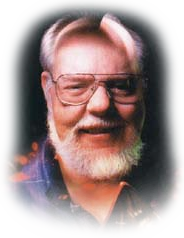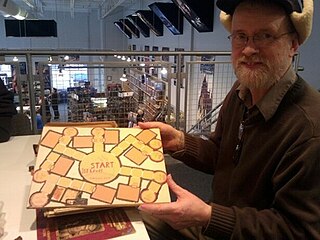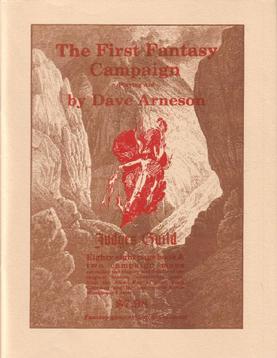History
1970s
Adventure board games often integrate various role-playing game mechanics, such as experience points and character creation into the board game format. The origins of these two types of game are related. In the early 1970s, Dave Arneson introduced his role-playing game, Blackmoor, to a group of players. One of those players, Gary Gygax, collaborated with Arneson to create Dungeons & Dragons (1974). Another member of that gaming group, Dave Megarry, translated the experience into the board game, Dungeon! (1975), the first adventure board game. [1] In fact, the term "adventure gaming" in the 1970s referred to what later became known as tabletop role-playing games, and only later became associated with board games. [2] : 306
1980s
The genre saw a particular boom in the 1980s, when its key subgenres had been codified by three major releases of the decade: [2] : 306
1990s
In the 1990s, both adventure board games and tabletop RPGs saw a sharp decline in popularity in the wake of the collectible card game boom and bust. [2] : 307

Dungeons & Dragons is a fantasy tabletop role-playing game (RPG) originally designed by Gary Gygax and Dave Arneson. The game was first published in 1974 by Tactical Studies Rules, Inc. (TSR). It has been published by Wizards of the Coast since 1997. The game was derived from miniature wargames, with a variation of the 1971 game Chainmail serving as the initial rule system. D&D's publication is commonly recognized as the beginning of modern role-playing games and the role-playing game industry, and also deeply influenced video games, especially the role-playing video game genre.

A role-playing game is a game in which players assume the roles of characters in a fictional setting. Players take responsibility for acting out these roles within a narrative, either through literal acting or through a process of structured decision-making regarding character development. Actions taken within many games succeed or fail according to a formal system of rules and guidelines.

David Lance Arneson was an American game designer best known for co-developing the first published role-playing game (RPG), Dungeons & Dragons, with Gary Gygax, in the early 1970s. Arneson's early work was fundamental to the development of the genre, developing the concept of the RPG using devices now considered to be archetypical, such as adventuring in "dungeons" and using a neutral judge who doubles as the voice and consciousness of all characters aside from the player characters to develop the storyline.

Blackmoor is a fantasy role-playing game campaign setting generally associated with the game Dungeons & Dragons. It originated in the early 1970s as the personal setting of Dave Arneson, the co-creator of Dungeons & Dragons, first as a setting for Arneson's miniature wargames, then as an early testing ground for what would become D&D.

A campaign setting is usually a fictional world which serves as a setting for a role-playing game or wargame campaign. A campaign is a series of individual adventures, and a campaign setting is the world in which such adventures and campaigns take place. Usually a campaign setting is designed for a specific game or a specific genre of game. There are numerous campaign settings available both in print and online. In addition to published campaign settings available for purchase, many game masters create their own settings, often referred to as "homebrew" settings or worlds.

An adventure is a playable scenario in a tabletop role-playing game. These can be constructed by gamemasters for their players, and are also released by game publishers as pre-made adventure modules. Different types of designs exist, including linear adventures, where players move between scenes in a pre-determined order; non-linear adventures, where scenes can go in multiple directions; and solo adventures, which are played alone, without a game group.

Empire of the Petal Throne is a fantasy role-playing game designed by M. A. R. Barker, based on his Tékumel fictional universe. It was self-published in 1974, then published by TSR, Inc. in 1975. It was one of the first tabletop role-playing games, along with Dungeons & Dragons, and was the first published RPG game setting. Over the subsequent thirty years, several new games were published based on the Tékumel setting, but to date none have met with commercial success. While published as fantasy, the game is sometimes classified as science fantasy or, debatably, as science fiction.

Arkham Horror is a cooperative adventure board game designed by Richard Launius, originally published in 1987 by Chaosium. The game is based on Chaosium's roleplaying game Call of Cthulhu, which is set in the Cthulhu mythos of H.P. Lovecraft and other horror writers. The game's second edition was released by Fantasy Flight Games in 2005, with a third edition in 2018.

The history of role-playing games begins with an earlier tradition of role-playing, which combined with the rulesets of fantasy wargames in the 1970s to give rise to the modern role-playing game. A role-playing game (RPG) is a type of game in which the participants assume the roles of characters and collaboratively create stories. Traditionally all the participants but one take on characters and determine the actions of their characters based on their characterization and the actions succeed or fail according to a system of rules and guidelines, and one of the participants takes on the role of game master who narrates the story, plays all the non-player characters and determine the challenge rating and the outcome of various actions. Within the rules, the participants may improvise freely; their choices shape the direction and outcome of the games.

Role-playing games (RPGs) have developed specialized terminology. This includes both terminology used within RPGs to describe in-game concepts and terminology used to describe RPGs. Role-playing games also have specialized slang and jargon associated with them.
James M. Ward is an American game designer and fantasy author who worked for TSR, Inc. for more than 20 years.

Michael Mearls is a writer and designer of fantasy role-playing games (RPGs) and related fiction. He was the senior manager for the Dungeons & Dragons research and design team. He co-led design for the 5th edition of the game. He also worked on the Castle Ravenloft board game, and various compendium books for 3rd, 4th, and 5th editions Dungeons & Dragons.

The Dungeons & Dragons Basic Set is a set of rulebooks for the Dungeons & Dragons (D&D) fantasy role-playing game. First published in 1977, it saw a handful of revisions and reprintings. The first edition was written by J. Eric Holmes based on Gary Gygax and Dave Arneson's original work. Later editions were edited by Tom Moldvay, Frank Mentzer, Troy Denning, and Doug Stewart.

A tabletop role-playing game, also known as a pen-and-paper role-playing game, is a form of role-playing game (RPG) in which the participants describe their characters' actions through speech. Participants determine the actions of their characters based on their characterization, and the actions succeed or fail according to a set formal system of rules and guidelines. Within the rules, players have the freedom to improvise; their choices shape the direction and outcome of the game.

David R. Megarry is a game designer most notable for the board game Dungeon!.
Braunstein is an experimental game and game genre introduced by David Wesely, a member of the Midwest Military Simulation Association, in the late 1960s, and originally played in the Twin Cities. Braunstein was important and influential in the early history of role-playing games.

Adventures in Fantasy is a role-playing game published by Excalibre Games in 1979, designed by Dave Arneson and Richard Snider. The game is a fantasy system, similar to early Dungeons & Dragons (D&D), which Arneson co-created. It received mixed to negative reviews in game periodicals, including The Space Gamer, Ares, and Pegasus, and ultimately flopped. Arneson later bought the rights to Adventures in Fantasy and published a new edition in 1981 through his own company Adventure Games.

The First Fantasy Campaign is a supplement for fantasy role-playing games written by Dave Arneson and published by Judges Guild in 1977.
A digital tabletop game is a video game genre that includes video games that have gameplay similar to physical tabletop games, including board games, card games, and role-playing games. Many digital tabletop games are adaptions of existing physical games into the video games, though some of these are wholly digital games that use tabletop game mechanics. There are also tabletop game simulators that allow for users to recreate tabletop games from a variety of game pieces.

Actual play, also called live play, is a genre of podcast or web show in which people play tabletop role-playing games (TTRPGs) for an audience. Actual play often encompasses in-character interactions between players, storytelling from the gamemaster, and out-of-character engagements such as dice rolls and discussion of game mechanics. The genre emerged in the early 2000s and became more popular throughout the decade, particularly with the 2015 debut of Critical Role, an actual play webseries featuring professional voice actors.












